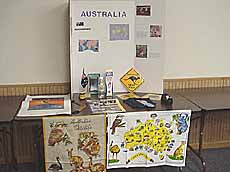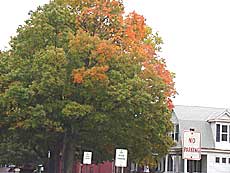|
Composting
of leaves and other landscape waste not only disposes of leaves but also
provides for a useful end product in compost. It is ironic that many people pay
to have leaves disposed of and next spring will go and buy bagged compost for
use in gardens, flower pots, etc. To provide you with knowledge about
composting, Extension has developed an at-home study course on home composting.
The six lessons will be mailed to you at your home and will take about 15 to 20
minutes each. Since we are in the heart of leaf season, we’ll double up and
mail two lessons per week to you and speed you on your way.


Lessons
included in the course include: "Why Compost Yard Trimmings,"
"The Composting Process," "Materials and Methods for Composting,
Locating and Building Your Compost Pile," "Benefits and Uses of
Compost," and "Reduce, Reuse, and Recycle – Other Options for the
Homeowner." Quizzes are built into each lesson to help you review
information. Best of all, the series is offered to you at no charge by
co-sponsors University of Illinois Extension, the Logan County Joint Solid Waste
Agency and the Lincoln Junior Women’s Club.

For
those of you wanting the short course on composting, here goes a brief summary.
A good mix for compost consists of three parts "browns" (materials
such as dead leaves) that are high in carbon and one part "greens"
(such as fresh grass clippings, garden prunings or those hanging basket
materials you are disposing of now). Composting materials should feel moist but
not overly soggy. When you begin the compost process, the temperature of your
pile should feel warm to the touch except in the cold winter months. To prevent
unpleasant odors that can occur when materials decompose without oxygen, your
pile should be turned to make sure air is reaching the center of the pile.

[to top of second column in
this article]
|

All
you need to compost is the will to do it, yard or food waste (except meat or
dairy products) and some space. Piles don’t need to be enclosed, but a bin or
similar enclosure is often used. Compost bins can be bought or constructed with
common materials such as wire, snow fence, lumber, used pallets or bricks. A
four-cubic-foot area out of direct sun is ideal for a compost pile location. You
can start any time of the year, but fall is when most piles get started, because
of the abundance of leaves. Your materials should be added and water mixed into
the compost as needed so that materials feel like a moist, wrung-out sponge.
Turn the pile in a few weeks so you exchange the outside areas with the center
of the pile. Turn the pile monthly after this except in the December through
February period, adding water when needed.

Avoid
adding meat and dairy products, weeds such as poison ivy, and extremely diseased
plants to your pile. Adding meat or dairy products is an invitation to the
four-legged critters to your yard. The addition of tree branches larger than a
pencil will also cause possible problems with the compost process. Larger
branches should be run through a chipper first if you want to compost them.

An
alternative method is to mix materials in a 30- to 40-gallon plastic garbage bag
(dark colors will heat faster). Add about one quart of water, about one-fourth
cup of nitrogen fertilizer and a cup of lime to your mix and shake well. Since
this is anaerobic method (without air) you definitely don’t want to poke a
hole in the bag. You should have compost from the bag method in about 6 to 12
months. Compost is finished when it is a dark, crumbly texture that has no
visible signs of the original materials added to your pile. It also has a very
earthy odor to it.

If you are
interested in signing up for the home study course or have further questions,
please call the Extension Office at 732-8289.
[John
Fulton]
|
|

[The Canadian display -- made by Wide-A-Wake 4-H Club]
Erin
Robinson, an Illinois State University student, was the featured speaker. She
visited Australia last summer as part of the 4-H International Foreign Youth
Exchange. In Australia, it is the winter season during our summer season. From
her experience she explained differences between Australian and American culture
and what life is like for Australian citizens.

[The Australian display -- made by Chester 4-H Club]

[to
top of second column in this article]
|

[The Nepal display -- from Hartem Clovers 4-H Club]
Chester
4-H Club represented Australia with their displays and foods; Hartem Clovers
represented Nepal; Hartem Achievers chose Mexico for their dishes and display;
and Wide-A-Wake 4-H Club prepared Canadian dishes and a display.

[The Mexico display -- made by Hartem Achievers 4-H Club]
To learn more
about the 4-H International Foreign Youth Exchange or about the 4-H program,
please contact the Logan County 4-H office at 732-8289.
[Logan
County 4-H news release]

[Erin Robinson, our guest speaker, who talked about her visit to
Australia]
|
|

To
understand the process that creates color, we need to know a little about basic
tree growth. A tree has two parts in its vascular system: the xylem and the
phloem. A tree’s xylem cells can be thought of as thousands of minute soda
straws packed end to end, going from the roots to the leaves. Water and
nutrients are taken up by the roots and transported to the leaves through the
xylem cells in the tree’s sapwood. In the leaves, water and nutrients are
converted into sugar, the energy that feeds the tree’s growth. This conversion
process, known as photosynthesis, happens in the presence of chlorophyll and
sunlight.

The
phloem is a thin layer of cells found in the inner bark of the tree. This is
where the sugars move from the leaves to the roots and other storage sites
within the tree. The location of the phloem shows how a tree can be severely
injured or killed if its bark is damaged. If the phloem is disrupted, food can’t
flow through the phloem and the roots starve to death.
Fall
coloration starts with the onset of senescence, a natural process that disrupts
the tree’s vascular system. This is the orderly process in which the
light-gathering and carbon-capturing substances in the leaves, including the
pigments that capture sunlight and the proteins that use the captured energy,
are disrupted and broken down. The change is started by the tree’s genetic
ability to "sense" day length and temperature variations. Fall’s
shorter days with less light and different light intensity, along with the
cooler and longer nights, affect the production of growth regulators that
trigger senescence.
The
long and warm days of summer produce high levels of the auxins and gibberellins
that stimulate tree growth and low levels of growth inhibitors. These stimulate
a variety of changes, including the formation of corklike cells at the base of
the leaf petiole, which produces a brittle zone around the vascular tissue so
that it is easy for the leaf to break off from the branch. Eventually only the
dead xylem cells are left holding the leaf on the tree. Heavy winds or rains can
easily break this fragile connection, causing leaves to fall to the ground.
[to
top of second column in this article]
|

The
shorter days and cooler temperatures get the tree ready for dormancy.
Chlorophyll production drops dramatically from the high levels of the growing
season to virtually nothing. The tree’s priorities then switch to the
production of sugars that will be stored for next season’s growth. This
reduction in chlorophyll production starts the visible fall colors. Chlorophyll
is the predominant pigment and makes the leaves green during the growing season.
Chlorophyll is also very fragile and must be replaced by plants on a continual
basis until the days grow short and temperatures fall. The fading of the green
color, due to much lower chlorophyll production, causes the other pigments once
masked by the green chlorophyll to come through. These other pigments include
yellow, orange, and buff colors of the carotenoid, xanthophyll and tannin
pigments.

Carotenoids
are always present in the leaves, so fall’s yellow to orange colors are
usually fairly consistent from year to year. Xanthophyll is a yellow to
tan-colored pigment, and tannins are responsible for the brown earth tones found
in oak leaves. A fourth pigment called anthocyanin does not naturally occur in
the leaves but is a product of senescence and concentrated sugar sap in the leaf
cells. Anthocyanins appear red and generate the varying shades of blue, purple,
and red that provide some of the most vibrant color displays. The actual color
depends on the pH of the cell sap, with acidic saps causing red to orange while
neutral to alkaline saps will appear purple to blue. Not all trees produce
anthocyanins, with sugar and red maples, dogwoods, sumac, black gum, sweet gum,
scarlet oak, sassafras, persimmon, hawthorn, and white oak producing the most
brilliant shades of red, maroon, purple and blue.
Hopefully this
somewhat scientific explanation of fall colors will cause you to understand a
little better what went on within trees to bring about this abundance of fall
color.
[John
Fulton]
|